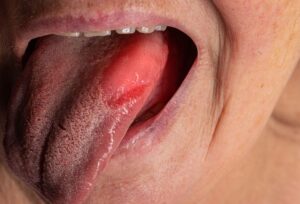What Is Geographic Tongue?
This guide is designed to help you understand a common and harmless condition called geographic tongue. Learning about what it is, what it looks like, and how it feels can provide reassurance and clarity. Geographic tongue is a benign inflammatory condition, meaning it is not cancerous or linked to any serious long-term health problems.


Podcast:
Learn More About Geographic Tongue
The condition gets its name from its unique, map-like appearance on the surface of the tongue. Key features you might notice include:
- Smooth, Red Patches: These are well-defined red areas where the tiny, thread-like projections on the tongue (called filiform papillae) have temporarily been lost, creating a smooth surface.
- Raised, White Borders: The red patches are typically surrounded by a slightly raised border that is yellow-white in color.
- A “Migratory” Pattern: A distinctive feature of geographic tongue is that the patches can seem to move. They may heal in one spot and appear in another, changing their size and shape over a period of days or weeks.
For most people, geographic tongue is completely asymptomatic, meaning it causes no pain or discomfort. However, some individuals may experience a burning sensation or increased sensitivity, especially when eating certain foods, such as those that are spicy or acidic.
While the appearance of geographic tongue is unique, its exact cause is not yet fully understood by medical experts.
What Causes Geographic Tongue?
Patients often want to know what causes a medical condition, but in the case of geographic tongue, the exact reason for its development remains unknown.
Medical science has not yet identified a specific cause. However, researchers have observed that geographic tongue appears more frequently in people who have certain other conditions, such as psoriasis (a skin condition) and reactive arthritis (a type of joint inflammation). This suggests there may be a shared underlying inflammatory or autoimmune pathway, though more research is needed to understand the connection.
While the direct cause is unclear, certain factors may be associated with a higher risk of developing geographic tongue.
Am I at a Higher Risk?
When we talk about “risk factors,” it’s important to understand that these are not direct causes. Instead, they are associations that have been observed in people who have geographic tongue. Having a risk factor does not mean you will definitely develop the condition.
Researchers have identified several potential risk factors and associations for geographic tongue:
- Psoriasis: A known inflammatory skin condition.
- Reactive arthritis: A form of inflammatory joint pain that can follow an infection.
- Family history: The condition may run in families, suggesting a genetic component.
- Specific genetic factors: Studies have linked the condition to certain genetic markers (like human leukocyte antigens or HLAs) that are involved in the body’s immune response, which may explain why it can run in families.
Understanding these associations can be helpful, but for most people, the focus is on practical, at-home strategies for managing any discomfort.
How Can I Manage Geographic Tongue at Home?
Since geographic tongue is a benign condition and often has no symptoms, management is focused on comfort rather than a cure. If you do experience discomfort, there are simple steps you can take to feel better.
Reassurance is Key
The most important aspect of management is understanding the nature of the condition:
- Most cases require no medical treatment at all.
- Geographic tongue is a benign condition and is not associated with any long-term health complications.
- The condition often follows a “relapsing and remitting” course. This means it can clear up on its own for a period of time and then reappear later.
Managing Discomfort
If your tongue feels sensitive or you experience a burning sensation, you can take steps to manage it at home.
- Avoid trigger foods: If you experience sensitivity, try to avoid spicy, acidic, or salty foods until the discomfort subsides. This step is only necessary if you are actively experiencing symptoms.
If avoiding these foods does not provide enough relief, a doctor or dentist can discuss topical medications to help manage symptoms.
When to See a Dermatologist
While geographic tongue is harmless, it is always a good idea to consult a provider for an official diagnosis the first time you notice symptoms. This ensures that your condition is correctly identified and helps rule out other, less common issues.
You should also schedule an appointment if you notice any of the following:
- The patches have an “atypical” appearance, such as not having the characteristic white border.
- The areas become significantly painful or do not seem to heal.
- You are experiencing other unexplained symptoms along with the changes on your tongue.
- The at-home management strategies for discomfort are not providing enough relief.
What to Remember
This final section summarizes the most important points for you to remember about geographic tongue.
- It’s a common and harmless condition: Geographic tongue is a benign inflammatory condition that is not linked to cancer or other serious health issues.
- It has a unique appearance: The condition is recognized by its characteristic map-like look, featuring migratory red patches surrounded by distinct white borders.
- It is often without symptoms: In many cases, the condition is completely asymptomatic and is only discovered during a routine dental or medical exam.
- Management focuses on comfort: If treatment is needed, its sole purpose is to relieve symptoms like sensitivity. Most people require no treatment at all.
